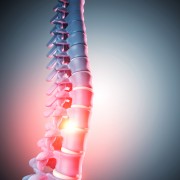Spinal stimulation helps paralysed men to move
Electrical stimulation of the spinal cord offers hope of movement for paralysed individuals

Four paralysed men have been able to move their legs for the first time in years after electrical stimulation of their spinal cords, say US doctors. The men were able to flex their toes, ankles and knees – but they could not walk independently.
The upbeat news comes on the back of a report published in the journal Brain that suggests electricity makes the spinal cord more receptive to the few messages that are still arriving from the brain after it is injured, and experts say it could become a form of treatment.
Research team pioneers spinal cord stimulation
A team at the University of Louisville and University of California has been pioneering electrical stimulation of the spinal cord below the injury. Three years ago, they reported that Rob Summers – a keen baseball player who was paralysed from the chest down in a hit-and-run car accident – was able to move his legs while supported on a treadmill.
Now, three patients who had been paralysed for at least two years and underwent the procedure regained some movement as a result. They were able to move their legs at a precise rhythm, and two of them were able to control the force of their movement.
The breakthrough confirms that function can be restored after paralysis and that the Rob Summers case was not a one-off.
Stimulation boosts spinal responsiveness
It’s not certain how the stimulation helps. However, the researchers believe that some signals are still traversing the injury, but they aren’t strong enough to trigger movement. The electrical stimulation made the lower spinal cord more excitable, so it was able to respond when messages did arrive from the brain.
Dr Roderic Pettigrew, Director of the US National Institute of Biomedical Imaging and Bioengineering, told the BBC in an interview: “Now that spinal stimulation has been successful in four out of four patients, there is evidence to suggest that a large cohort of individuals, previously with little realistic hope of any meaningful recovery from spinal cord injury, may benefit.”
Susan Howley, from the Christopher and Dana Reeve Foundation which funds spinal cord injury research, says the study confirms Mr. Summers’ case was “not an anomaly”.
Howley added: “The implications of this study for the entire field are quite profound, and we can now envision a day when epidural stimulation might be part of a cocktail of therapies used to treat paralysis”.
Further links:
Louisville.edu
News.bbc.co.uk
Related Articles
When should I see a doctor for hip pain?
Dr Andrew Dutton shares what to expect when seeing the doctor for hip pain
Read moreWhat if your child has joint pain?
Arthritis can significantly affect the life of young children if it is not treated early, according to Dr Cham Weng Tarng from Sunway Medical Centre
Read moreWhat causes back pain?
Dr Benjamin Tow discusses the most common causes of acute and chronic back pain
Read moreLatest Articles
Medical Care
Can a Stroke Lead to Dementia? What You Need to Know
Can Stroke Cause Dementia? Learn about the relationship between these two in our insightful article. Discover prevention and management strategies.
Read moreMedical Care
Clearing the Fog: Dispelling Common Diabetes Myths in Singapore
Uncover the truths and myths about diabetes with insights from Harmony Thyroid, Endocrinology and Diabetes Centre. Learn about prevention, diagnosis, and management strategies for diabetes in Singapore. Get expert guidance from Senior Consultant Endocrinologist Dr. Vikram Sonawane to navigate your diabetes journey effectively.
Read moreMedical Care
Achieving Swift Recovery: Enhanced Recovery (ERAS) Direct Anterior Approach Total Hip Replacement
Consider total hip replacement with Alps Orthopaedic Centre's ERAS Direct Anterior Approach for faster recovery and reduced hospital stays. Learn about Dr. Jerry Chen's expertise in Singapore.
Read more